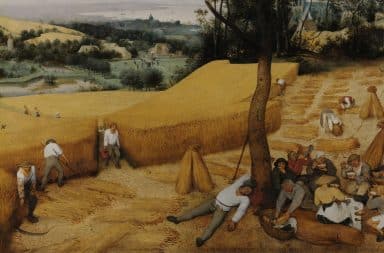William Shakespeare’s many influences have been well documented—Marlowe, Chaucer, Plutarch—but one can never underestimate the impact of Queen Elizabeth I. As patrons of the arts, Elizabeth and her court would actively steer playwrights towards certain themes. Elizabeth was especially fond of medieval morality plays, with their focus on allegory, virtue and car chases. Among her favorites were The Job of Italy (1469) and A Mery Historye of the Sherif Smokey and the Moste Witsome Bandit (1477).
Consequently, Shakespeare felt obliged to incorporate variations on the classic chase in many of his comedies, tragedies and—where creative licence allowed—his histories, resulting in the frenzied high-speed thrill rides that have delighted audiences for centuries.
Richard III
Shakespeare’s first recorded chase scene takes place in this historical tragedy, as Richard, having lost his horse, commandeers a Ford Mustang 390 GT and races through enemy lines at Bosworth towards his stables in Leicestershire. Flawlessly evading flaming arrows and jumping entire battalions, Richard ironically becomes bogged down in an early England snow just short of his destination, causing Richard to lament, “Now is the winter of our discount tires.”
A Comedy of Errors
Antipholus of Syracuse and Antipholous of Ephesus race through the streets of Ephesus in identical Fiats, comically thinking each one is chasing the other. Their servants Dromio (but the wrong Dromios) ride shotgun and provide hilarious, panicked asides. (“What is the course and drift of your compact car?”) Historians note that this play was first performed in 1594 at Gray’s Inn, with the resulting extensive damage causing Shakespeare’s players to be permanently banned from the public house.
Romeo and Juliet
This tragedy contains perhaps Shakespeare’s most exciting chase scene, as Tybalt boards a bullet train bound for Mantua, pursued by Mercutio and Romeo in a Dodge Charger that somehow manages to mount the tracks. (The Bard’s stage directions are unclear on the logistics.) Shakespeare takes liberties with the source material (A Tragicall Historye Both Faste and Furious of Romeus and Juliet, 1562) by having the bullet train pass implausibly through a convent filled with bathing nuns, reflecting Queen Elizabeth’s newfound fascination with gratuitous nudity. Famously, Romeo fucks it all up with a hand brake.
A Midsummer Night’s Dream
In keeping with the bucolic nature of this romance and perhaps as a reaction against his increasingly baroque and costly chase scenes, Shakespeare offers merely a nod to the trope in Midsummer as Titania chases a magically transformed Bottom (with the head of an ass) through the forest on bicycles. The scene is more comic than thrilling, particularly Bottom’s struggle with his helmet. Also includes Shakespeare’s first employment of a chase within a chase.
The Merchant of Venice
By now, audiences had come to expect a chase scene in Shakespeare’s plays, and the playwright was striving to keep things fresh. Here, Shakespeare mixes it up with jet boats through the canals of Venice piloted by Portia and Shylock, whose catchphrase “If you prick us, do we not speed?” was briefly popular on T-shirts.
Henry V
Having pulled off an elaborate heist against a villainous casino tycoon, King Henry and his Band of Brothers must speed across the landscape in a Chevrolet station wagon in order to make it on time for the Battle of Agincourt. In the process, they drive through three hay sheds, a jousting match, a minstrel fair, an archery contest, an unhappy wedding and a leper colony, all to jolly, chaotic effect. The warriors arrive just in time, stepping onto the battlefield only to realize that they must now use the battered car to penetrate enemy lines. This prompts Henry to recite his famous line, “Once more into the Caprice, dear friends!”
Julius Caesar
The chariot chase in Julius Caesar is one of the most familiar in the Shakespeare canon (“Gear two, Bruté?”) and has been imitated and parodied ad infinitum.
As You Like It
Oliver comes to the Forest of Arden to kill his brother Orlando but quickly repents after Orlando pushes him out of the path of a speeding but silent electric car that appears out of nowhere—a rare example of Shakespeare’s use of Prius ex machina.
Hamlet
Hamlet is pursued on skis by Rosencrantz and Guildenstern down the Swiss Alps and seems to plunge over a cliff, only to have a parachute emerge from his tunic, festooned with the Danish flag. His two former allies, meanwhile, plummet to their deaths. Due to its complexity, this scene is today rarely performed, although the Royal Shakespeare Company’s 1974 production with McQueen in the role received a glowing review in The Times entitled, “Ennui On Skis? Oui, Steve!”
Macbeth
The occult elements in Macbeth show the new influence of the recently ascended King James, whose favorite poem was The Broodinge Tale of Faire Bella and Edward, Fairer Stille. Yet Shakespeare still managed to incorporate a rousing chase into The Scottish Play as sworn enemies Macbeth and Macduff must temporarily team up in an M998 Humvee to escape Banquo’s ghost through Birnam Wood. Joining them is Lady Macbeth in the back seat screaming unhelpful instructions. While effective in context, many critics feel this scene is too derivative of Marlowe’s The Tragedie of Scooby of Doo.
King Lear
While it technically does not contain a chase scene, Shakespeare in one of his final plays goes meta, stipulating that if the actors deliver their lines slower than 50 words per minute, the entire production explodes. Considered one of Shakespeare’s densest and tensest works.
The Winter’s Tale
Contains Shakespeare’s most famous stage direction: “Exit, pursued by a Yaris.”


